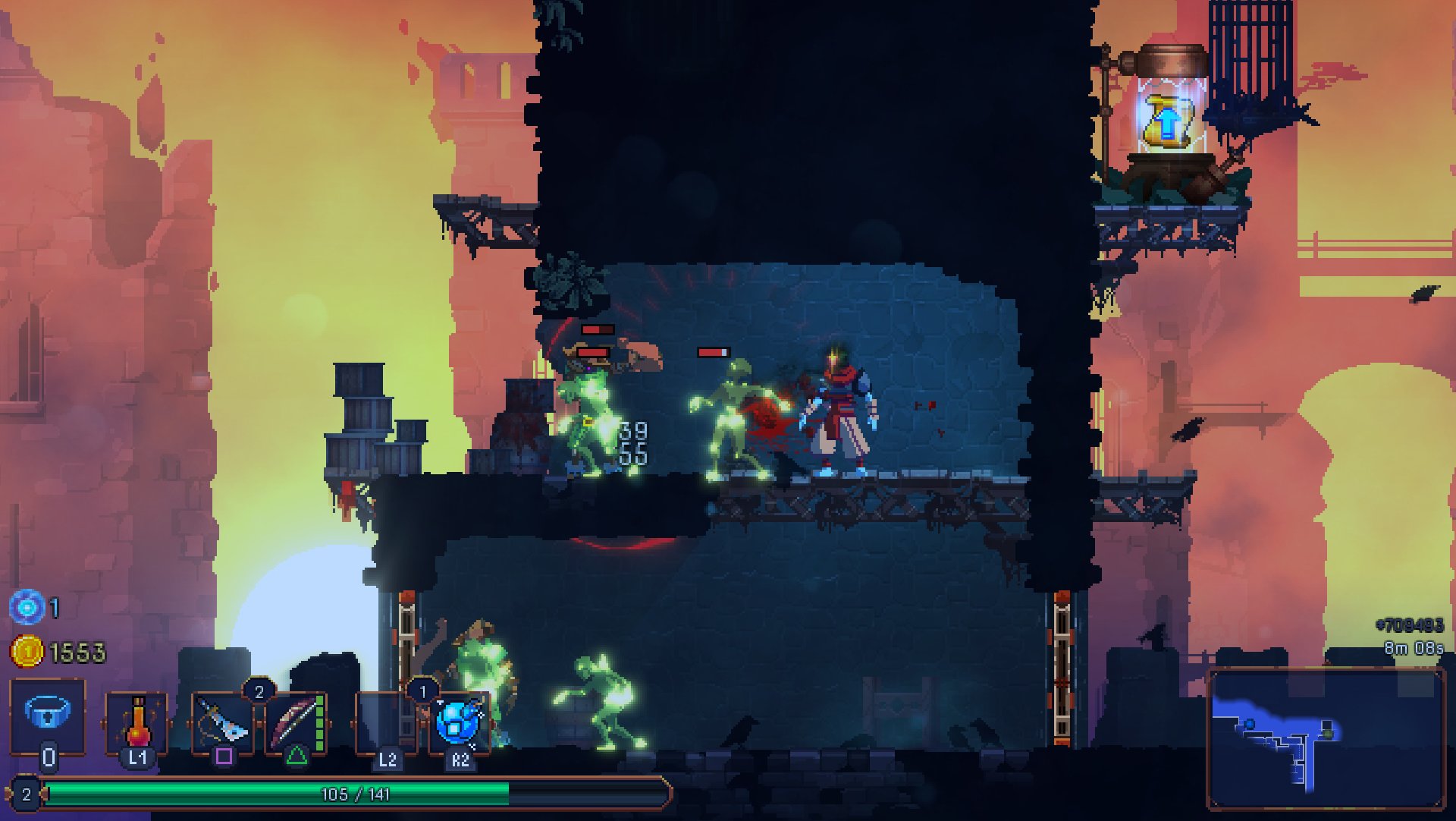Dead Cells is like an old school Castlevania gone roguelike
Prepare to die, and die, and also plant some vines, sometimes.
It’s just a gut feeling, but the modern platformer rogue-like might be very close to the end of its honeymoon period. Blame saturation, or blame the lack of new ideas, but at a glance it’s hard to muster much enthusiasm for what Dead Cells offers: it’s a 2D, 16-bit styled Metroidvania (veering rather closely to the -Vania part of that formulation) with permadeath and randomised levels.
Nonetheless, this Early Access title has been met with quite a bit of enthusiasm, so I spent a bit of time with its latest build recently. And while there was little in Dead Cells that surprised me, there was a lot that compelled me to keep playing it. It’s as moreish and punishing as the sub-genre demands, but the small evidences of polish and inspiration are what sets it apart from the rest of the pack.
A very excellent and important touch is that you play as a man with no head—a ripe roleplaying opportunity. This headless fellow must collect cells, for some reason, and is doomed to repeatedly do so. You start in a prison chamber which serves as a kind of nexus hub world, where retrieved weapon and gear blueprints hang proudly from glass jars. From here, you’ll enter a dank prison system which serves as the game’s first level, but unlike most platformer rogue-likes, Dead Cells’ linearity ends there.
At least, it does once you’ve learned abilities which will allow you to, for example, harvest the vine leaf slime balls that litter the map. Once these are harvested they’ll grow and allow access to previously inaccessible areas of a level. While you’ll probably need to grind a few hours in order to get this permanent power-up (it’s held by a non-randomised, mandatory boss), afterwards you’ll have the choice of going either up or down—and figuring out which is a better route is entirely up to you.
When this element emerges Dead Cells clicks, alleviating the dread of repeating the same level themes with each death. These levels branch off in genuinely interesting ways, and while the themes aren’t especially mind-blowing (poisonous sewers, forests, towering ramparts), the art is very beautiful and varied enough to make exploration feel worthwhile. It’s true that the first couple of hours spent playing Dead Cells feels like a grind—a grind with excellent combat—but once the world structure and how you’ll traverse it opens out, it turns into something potentially great.
That combat is a definite drawcard: Headless One starts out with a rusty sword, and a choice between a bow and a shield. I rarely used the shield because you can’t turtle it: you need to have actual reflexes to deflect projectiles. But the balletic dodge roll and slash rhythm is very rewarding, and Dead Cells’ enemies are all geared to demand different approaches. It’s a lot of fun to use even the starter rusty sword, but you’ll soon unlock blueprints for other weapons, or else randomly encounter them in the maps. My favourite was an electrified whip which barely needed any skill to apply, though the Blood Sword (it causes bleeding damage) and the secondary freeze projectiles proved important when facing off against bosses.
As for the randomised level design—it’s serviceable. Each area is sprinkled with access to secret challenge levels and “cursed” chests, which yield high rewards but make the Headless One very weak. The aforementioned branching paths between levels are enticing, but after a while the environments themselves begin to resemble mazes—and not ones you’re likely to get lost in, thanks to the mini-map. In open-air areas, such as the Promenade of the Damned, buildings dip in and out of the ground, leading often to dead ends, but just as often to power-ups and hints at places accessible in some far off future. I don’t think I really scraped the surface of what was out there in terms of abilities, but they included a Phaser, which allows a short teleportation to the rear end of a nearby enemy.
Keep up to date with the most important stories and the best deals, as picked by the PC Gamer team.
Meanwhile, the permanent upgrade features, such as more healing flasks, stronger weapons and better gold yield—among others—use a cell currency. These are acquired through combat but lost upon death. In early game you’ll likely end up with around 15 before dying, and you must use all cells between major levels in order to proceed. Since a lot of power-ups need between 5 and 50 cells to upgrade, expect to spend a lot of time in early game grinding. Thankfully the combat feels good enough to make this fun, though it does get a bit mindless.
A podcast game, then? Yes and no. You’ll definitely want to grind, though on runs where you aim to make meaningful progress—such as those where you’ll face off against a boss—it’s very important to focus, to not let even the lowly mobs get the better of you. I liked this about Dead Cells: the pace and tension is as low or high as you want it to be, and you’re always going to make a little bit of progress anyhow. The game is still in Early Access, with updates forthcoming which will include more weapons and items, NPCs, stats, and enemies. It’ll be worth keeping an eye on.

Shaun Prescott is the Australian editor of PC Gamer. With over ten years experience covering the games industry, his work has appeared on GamesRadar+, TechRadar, The Guardian, PLAY Magazine, the Sydney Morning Herald, and more. Specific interests include indie games, obscure Metroidvanias, speedrunning, experimental games and FPSs. He thinks Lulu by Metallica and Lou Reed is an all-time classic that will receive its due critical reappraisal one day.


